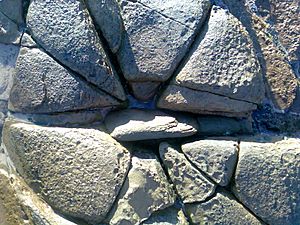Fracture (geology) facts for kids

In geology, a fracture is like a crack or a break in a rock formation. Imagine a piece of glass that breaks into two or more parts; rocks can do something similar! These breaks can be small, or they can be very large, forming deep, wide cracks in the Earth's surface. Geologists, who study rocks and the Earth, call these breaks "fractures."
Contents
What is a Geological Fracture?
A geological fracture is a split or a break in a rock formation. It divides the rock into two or more pieces. Two common types of fractures are joints and faults.
How Do Fractures Form?
Fractures usually happen when a rock is under too much stress. Stress is like a pushing or pulling force on the rock. If the force is too strong for the rock to handle, it will crack at its weakest point. Think of bending a plastic ruler too much; it will eventually snap! Rocks do the same thing when they are stressed.
Why Are Fractures Important?
Fractures are very important in geology. They can create pathways inside the rock. These pathways allow fluids, like water or hydrocarbons (like oil and natural gas), to move through the rock. This is why fractures can be important for finding underground water or for drilling for oil.
Images for kids
-
The concentric circles in this sandstone are "plumose" (plume-like) structures that can form during the creation of a fracture.
See also
 In Spanish: Fractura (geología) para niños
In Spanish: Fractura (geología) para niños





